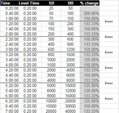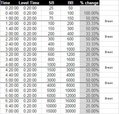I can't post the word doc I have for this, but I can copy/paste it. For future games with different numbers of players or desired lengths, use this:
BLIND STRUCTURE
Introduction
Your goal for designing a blind structure for a No-Limit tournament is to create a game that rewards good poker skills, while increasing the blinds over time to encourage the tournament to finish within a reasonable amount of time (say 2~3 hours).
In general, low blinds favor the better players. As the blinds start increasing, there is less room for players to maneuver -- eventually, the shorter stacked players will be forced to go all-in preflop.
Designing a blind structure, and the M concept:
Magriel's M can be thought of as a measure of how desperate a player is in a tournament. As a player's M starts to shrink, his ability to play "good" poker diminishes.
A player's M is calculated as:
M = Player's Current Chips / (Big Blind + Small Blind + Antes per orbit)
As a rough measure of how the blinds restrict a player:
* M>20 -- A player is unrestricted
* M~10 -- A player is close to the danger zone and must play more aggressively with weaker hands
* M<=5 -- A player must move all in preflop
You'll probably want to start your players off with an M>20 and less than 100 -- unless you want a fairly long game. Starting with an M of around 30~50 will allow your players plenty of room to maneuver, while allowing you to increase the blinds gradually for a 2~3 hour game. Longer tournaments will typically start players with much deeper stacks. The WSOP, for example, starts the players with an M of 133.
Examples:
* T2500 w/ 25/50 blinds, players start with M=33
* T5000 w/ 25/50 blinds, players start with M=66
Similar to a player's M, the overall tournament M (tM) is a measure of how a tournament is progressing. Typically, a tournament will end around the time when tM = 10. It is possible for the tournament to end sooner, but it's hard for it to end too much later (unless your players are VERY passive).
tM = (sum of ALL chips in play) / (Big Blind + Small Blind + 2xAntes)
Sum of all chips in play = Number of Players x Starting stack + Rebuys + Addons
If you want the shortcut method to ballpark the required blinds:
No Antes:
Small Blind = Sum of all chips in play / 30
Antes:
Small Blind = Sum of all chips in play / 40
Ante = Small Blind / 3
Given these new bits of knowledge, we'll refine our goal for creating a tournament structure:
We want to allow the players to start with a reasonable M, and increase the blinds gradually such that tM=10 when we want the tournament to end.
Number of blind levels:
Typically, you'll want your blind levels to last at least 15 to 20 minutes so that you get at least one full orbit at a full table. For a 2 hour tournament, you have time for eight 15 minute levels. For longer games, you have the option of increasing the number of levels, or increasing the time between levels (or both!).
Blind structure Rules-of-thumb:
* Having more blind levels allows for slower blind increases
* Starting players with a larger M means that the blind increases will be more aggressive
* Avoid having level jumps of more than 2x the previous level
* Try to design your structure to color out low denomination chips as the tournament progresses
* You'll want your final blind level such that tM ~ 10
* Feel free to place additional levels after the predicted end point for the tournament to insure that the game ends for certain
Construction example:
Starting chip stack T1500, 10 players, no rebuys/addons
2 hour tournament -> 8 levels at 15 minutes each
We know our 8th level should have SB = 1500x10 / 30 = 500, BB=1000
If we start our 1st level at 10/20, players have a M=50 (good).
So our structure looks as follows:
[10/20], ?, ?, ?, ?, ?, ?, [500/1000]
Filling it in using our rules-of-thumb:
[10/20], [15/30], [25/50], [50/100], [100/200], [150/300], [300/600], [500/1000]
We see only a few 2x jumps in the blinds, otherwise the increases are fairly gentle.
An alternate method to tournament structure construction is to compute the final blind level, and use our rules-of-thumb to work backwards for the desired number of levels.
Example:
Starting chip stack T3000, 10 players, no rebuys/addons
8 level tournament, no antes
Ending blind level: SB = 3000x10 / 30 = 1000, BB = 2000
[1000/2000], ?, ?, ?, ?, ?, ?, ?
Using our rules of thumb:
[1000/2000], [800/1600], [500/1000], [300/600], [200/400], [100/200], [50/100], [25/50]
End result:
25/50
50/100
100/200
200/400 (color out T25)
300/600
500/1000
800/1600 (color out T100)
1000/2000
Now, we just need to check the starting M. Starting M = 3000 / (25+50) = 40 -- good! We'll also need to check to make sure that we're coloring out the low denom chips at a reasonable time.



